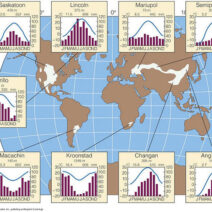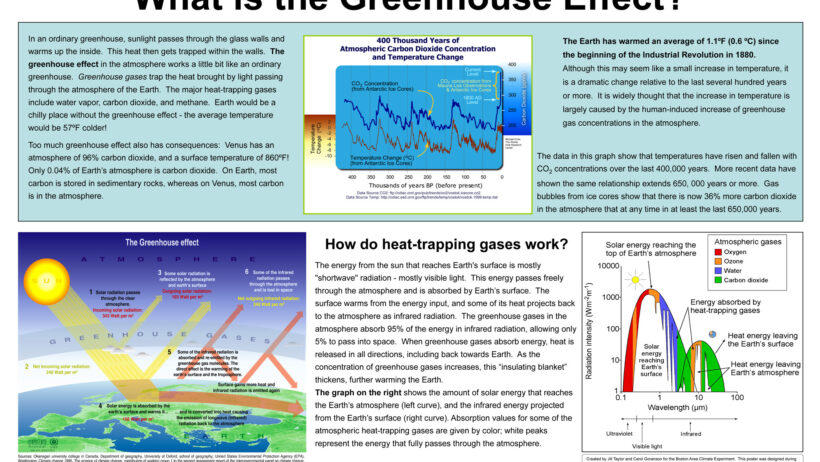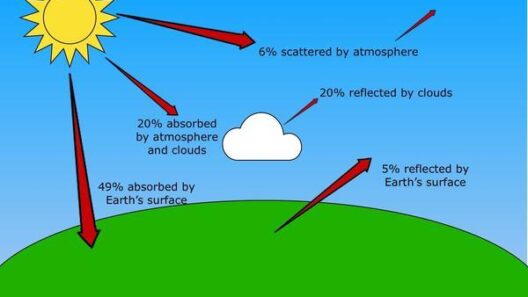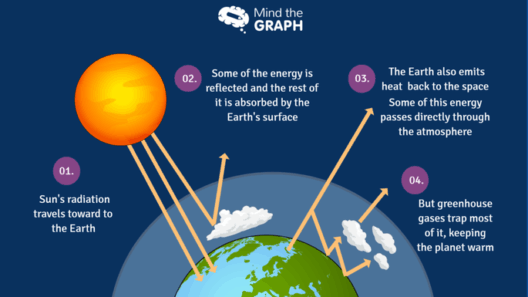The greenhouse effect is often likened to a warm blanket enveloping the Earth, providing the necessary warmth for life to flourish. However, this once-comforting metaphor now comes with a caveat; the blanket is becoming increasingly heavy, leading to dire consequences. Understanding how the greenhouse effect contributes to global warming requires a nuanced exploration of its mechanics, the role of greenhouse gases, and the resulting climate change. The resonance of this topic can no longer be ignored, as it has monumental implications for our planet and its future inhabitants.
In the delicate balance of our atmospheric ecosystem, solar radiation from the Sun is absorbed by the Earth’s surface, primarily the land and oceans. This absorbed energy is then re-emitted as infrared radiation—a form of heat. In a well-regulated environment, this heat would escape back into space. However, various gases in the atmosphere, known as greenhouse gases, trap this heat and create a warming effect. This phenomenon is akin to a well-tended garden: too much fertilizer can lead to overwhelming growth, and analogously, an excess of greenhouse gases can lead to a significant climate imbalance, exacerbating global warming.
But what are these greenhouse gases that contribute to the planet’s thermal embrace? The primary culprits include carbon dioxide (CO2), methane (CH4), nitrous oxide (N2O), and fluorinated gases. Each of these gases has a distinct contribution to the greenhouse effect. Carbon dioxide, for instance, is released primarily through human activities such as fossil fuel combustion, deforestation, and industrial processes. Methane, although present in smaller quantities, is far more potent than CO2; produced from livestock digestion, landfills, and rice cultivation, it poses a significant threat to our climate by trapping heat efficiently over a short period.
Deforestation plays a dual role in this narrative. Trees not only absorb CO2 as part of the natural carbon cycle, but they also release moisture into the atmosphere. When forests are cleared for agriculture or urbanization, the removal of these trees translates into diminished carbon absorption, further exacerbating the accumulation of greenhouse gases. It is as if the planet is losing its natural filter, leading to hotter temperatures and unpredictable new weather patterns. The soil, once rich and robust, becomes impoverished, thereby affecting agriculture and biodiversity—a greening Earth struggling under the weight of its own blanket.
Moving to nitrous oxide, it emerges primarily from agricultural activities, particularly the use of synthetic fertilizers. Nitrous oxide molecules hold the unique property of being far more effective than CO2 in trapping heat—approximately 298 times more potent over a 100-year period. The cascading effect of agricultural practices, when amalgamated with fossil fuel emissions, creates an ominous feedback loop, amplifying the greenhouse effect with every passing year.
The greenhouse gases dance in an intricate cha-cha of cause and effect, and their collaboration leads to a rise in global temperatures. This effect is measurable: an increase by a mere 2 degrees Celsius can result in cataclysmic events, such as extreme weather patterns, loss of biodiversity, and rising sea levels. Each ripple of change serves as a harbinger for a future that appears increasingly hostile and unpredictable.
One of the more insidious impacts of the greenhouse effect is its contribution to the melting of glaciers and polar ice caps. These ice formations, which are often seen as the world’s refrigerator, play a crucial role in regulating sea levels. As they melt, they raise sea levels, inundating coastal communities while simultaneously disrupting marine ecosystems. Imagine the once solid ice—now fragile and thin—shifting under the weight of history, a reminder of the fragility of our climate.
Climate change extends beyond environmental consequences; it has profound sociopolitical implications as well. Communities worldwide are experiencing the brunt of climate change, with marginalized populations disproportionately affected due to their limited resources and adaptability. Natural disasters increase in frequency and severity, leading to displacement, food insecurity, and resource conflicts. The World Bank predicts that over 200 million people may be forced to migrate due to climate change by 2050. A devastating flood does not discriminate, but it often leaves in its wake the most vulnerable, exacerbating pre-existing inequalities.
The interconnectedness of ecosystems illustrates the far-reaching effects of the greenhouse effect on global warming. Disruption in one area can lead to a cascade of unintended consequences, affecting both flora and fauna. Biodiversity loss drawn from changing habitats or the extinction of species diminishes the resilience of ecosystems, making it harder for them to adapt to rapid changes. The balance is delicate; every plant that dies and every animal that goes extinct is a note deleted from nature’s symphony, altering its composition irreversibly.
In mitigating global warming, targeted efforts against greenhouse gas emissions are imperative. Transitioning to renewable energy sources such as wind, solar, and geothermal power could significantly diminish our dependence on fossil fuels. Conservation practices, sustainable agriculture, and reforestation efforts can enhance carbon sequestration and rejuvenate natural systems. It is not merely a choice; it is a necessity. The mitigative actions we take today will save the Earth from bearing the burden of a suffocating blanket tomorrow.
In summation, understanding the mechanisms of the greenhouse effect and its role in global warming is crucial in addressing the climate crisis. It is not simply a scientific phenomenon; it is a daunting challenge that requires collective action on an unprecedented scale. Humanity stands at a crossroads—acknowledging the plight of our planet through informed action can ensure that future generations inherit a world thriving rather than merely surviving under the warming blanket of greenhouse gases.






